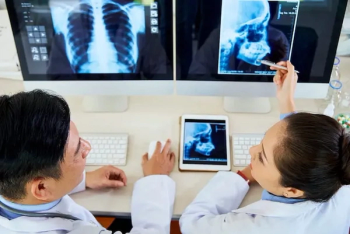A new meta-analysis suggests that computed tomography-based coronary artery calcification (CAC) score may offer significant predictive insights into the risks of major adverse cardiovascular events (MACEs) and overall survival for patients undergoing curative treatment for lung cancer.
For the meta-analysis, recently published in Academic Radiology, researchers reviewed data from seven studies to examine the prognostic impact of the CAC score in determining MACE risk and overall survival (OS) in this patient population.1 The total cohort was comprised of 2,292 patients (mean age of 68) receiving curative treatment for lung cancer, according to the meta-analysis.
In a multivariable analysis that included five of the reviewed studies and 1,836 patients, the researchers noted a pooled hazard ratio (HR) of 1.56 for the association between CAC score and OS. The study authors also pointed out a pooled odds ratio (OR) of 1.97 for the association between CAC score and MACE risk, based on two of the reviewed studies and a total of 502 patients.1
“Presumably, the inclusion of CAC scoring into prognostic scores for lung cancer patients could increase the prognostic stratification in these patients. The inclusion of CAC score would include a parameter of an important cardiovascular risk factor in these patients. However, prospective studies are needed to provide reliable data of the prognostic relevance of CAC score for clinical routine in lung cancer patients,” wrote lead meta-analysis author Hans-Jonas Meyer, M.D., who is affiliated with the Department of Diagnostic and Interventional Radiology at the University of Leipzig in Leipzig, Germany, and colleagues.
Citing recent research, the study authors noted that unreported or underestimated calcifications may occur in up to a third of cases involving CT lung cancer screening and can lead to decreased utilization of appropriate statins for treatment.2
Three Key Takeaways
- Prognostic value of CAC scoring. Coronary artery calcification (CAC) scores, derived from CT imaging, demonstrate significant predictive value for major adverse cardiovascular events (MACE) and overall survival (OS) in lung cancer patients undergoing curative treatment.
- Importance of reporting CAC. Unreported or underestimated coronary calcifications in lung cancer CT screenings are common and may reduce statin utilization, impacting cardiovascular risk management.
- Need for further research. Despite promising insights, prospective studies are required to confirm the clinical utility of CAC scoring in lung cancer patients and standardize its integration into routine prognostic models. Limitations of current data include study heterogeneity and the reliance on non-cardiac gated CT.
“This highlights the importance of the correct reporting of coronary calcifications by the radiologist in every CT investigation,” emphasized Meyer and colleagues.
The researchers did concede a few caveats in the assessment of CAC scores. Male patients generally have slightly higher CAC scores than women, according to the study authors. They also pointed out that the absence of calcified plaques in cases of patients with known amnestic coronary heart disease (CHD) may trigger CAC scores of zero.
(Editor’s note: For related content, see “Photon-Counting CTA for Patients with PAD: What the Research Reveals About Assessment for Stenotic Lesions,” “Multicenter Study Shows Capability of AI CCTA Analysis for Predicting Major Adverse Cardiovascular Events” and “Computed Tomography Study Examines Potential of Automated Coronary Artery Calcium Scoring with Deep Learning.”)
In regard to limitations of the meta-analysis, the authors acknowledged a lack of homogeneity between the reviewed studies and the exclusion of non-English studies. The researchers also noted that CAC scoring was performed with non-cardiac gated CT and the cohort for the meta-analysis was entirely comprised of patients with curative intent.





